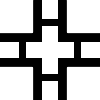Thor's Cross

Thor's Cross is a misnomer: The symbol is not supposed to represent a cruciform, rather it is a hammer and seldom seen in a Christian context.
The hammer does, however, appear in several places in the Bible; as a war club, murder weapon, and tool for construction.
Christian symbol
In Christian iconography, a hammer usually represents the tool used to drive nails through the hands and feet of Jesus prior to his Crucifixion. (See Hammer and Cross and Tau Cross.)
Masonic symbol
In a Masonic context the heads also represent a hammer or an axe, and may be referred to as an Axe Head Cross or Brick-axe Cross, representing bricklayers and other construction trades. (See Axe Cross.)
Heraldic symbol
In heraldry it might be referred to as a Corniced, Cornished or Capiteau Cross composed of four columns with capitals.
Pagan symbol

Although it's a hammer, it is still a cross shape. And for some unknown reason it's almost invariably inverted like St. Peter's Cross and sometimes referred to as the Wolf's Cross. (This was the name given to an amulet discovered in Iceland, estimated to be around 1,000 years old and which might be Pagan, Christian, or possibly a mixture of the two.)
Another somewhat romantic name for this form is Viking Cross.
In Norse and German mythology, Thor is the powerful son of Odin. He rides around in a chariot pulled by two goats, curiously named Tanngrisnir (tooth grinder) and Tanngnjóstr (tooth gnasher). If he gets hungry, he eats one of the goats. It doesn't matter which one, because when he gets hungry, he gets very hungry and eats both. On touching the carcasses, the goats are instantly restored to health and can be put back to work.
Thor wields a hammer, called a Mjöllnir and every time he throws this, thunder is heard in the area. (The Swedish for thunder is tordön, translated as "Thor's din".) The hammer has magical boomerang properties in that it flies back to its owner after hitting the target. We humans can hear this as the thunder ricochets from hill to hill.
It's a good idea not to annoy this god. When he comes storming after sinners, the sparks of his chariot wheels create the lightning we see. (See also the Taranis wheel)
The god was so powerful and popularly feared, that a day of the week was named after him: Thursday.
And this god is seriously into recycling: With his ability to resurrect his goats, the echoing from his boomerang hammer, and his regular weekly appearances on our calendar, this god will no doubt be around for a long time.
Fashion symbol

The angular design is popular in fashion products.
The photo of a pendant on the right was sent to us by someone with a question about its history. (If you can identify the origin of this design, please let us know and we'll forward your message to the pendant's owner.)
If it has a religious connection (if!) then the overall angular shape looks Teutonic, and each of the four parts incorporate a royal/heraldic fleur de lis. There is also similarity with the St. Chad's Cross.
The pendant is similar to the 2004 logo of the fashion brand Tory Burch, whose website toryburch.com/about-us/ explains that the double hammers are in fact double-Ts, where the lower T is mirrored with an inverted upper T.
Each T incorporates curves inspired by Moroccan architecture.

The lower T is, of course, Tory's initial letter, and the mirrored upper is inspired by the 60's and 70's interior designer David Hicks, whose own logo (shown on the left) is of four H's arranged as a cross.
Jeremiah 51:20
Judges 4:21
The Romans followed the idea of having two animals pull their chariots and as you can read here, this may have had influence on modern day space travel.
Who knows, one day the circle will be complete when an astronaut catches a glimpse of Thor.





